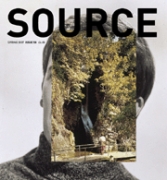Staged Romanticism
Edward S. Curtis - Gallery of Photography 2007
Review by Justin Carville
Issue 50 Spring 2007
View Contents ▸
In conjunction with Edward Curtis's Sacred Legacy exhibition, the Gallery of Photography proposed to organise a workshop on alternative photographic processes. Recently described as photography's 'antiquarian avant-garde', the cyanotype, platinum printing and toning with various precious metals have all resurfaced within contemporary photographic culture. A reactionary turn, no doubt, to photography's chemical past in the face of its digital future. It is ironic that this interest in Curtis's use of alternative processes appears to be the only thing salvageable from his massive ethnographic survey of the culture of the North American Indian. Though perhaps even more ironic is what has been lost amidst this rescuing of Curtis's photographic legacy; that the displacement of North American Indians from their tribal lands was in part due to the mining industry's desire to get access to the very types of precious metals used in the production of his photographic imagery.
The processes used by Curtis in his vast photographic project to capture for posterity the social and material culture of the Native American, is a prominent feature of the contextualisation of both his mammoth project The North American Indian and its manifestation as a contemporary photographic exhibition. Amongst the exhibition acknowledgements is one for a master printer, and, in museological fashion, print titles are followed by the physical designation 'silver', 'albumen' or 'photogravure'. This focus on the photograph as object is reinforced by a set of gold-toned prints. Presented in small, dark, wooden frames, they are marked out as photographically, aesthetically and metallurgically more precious than the other exhibited images. The Oath - Courtesy the Gallery of Photography
The Oath - Courtesy the Gallery of Photography
The emphasis on photographic processes is in part establishing Curtis as a master of his craft, part the aestheticisation of photography - both standard fare for the construction of the auteur within the photographic canon. However, there is a degree of historical amnesia in the concentration on the aesthetic dimension to Curtis's use of elaborate and expensive image production rather than cheap, mass-produced photographic imagery. What has been overlooked is that toning and platinum printing were frequently undertaken to ensure longevity of the photographic print. Curtis's use of these processes must at least in part be attributable to their suitability to his archival project. After all, The North American Indian was founded not only on Curtis's photographs, but also his vast archive of moving-image footage and wax cylinder recordings of language and music. The emphasis on the aesthetics of the photographic print merely serves to shift attention away from what should be the central subject of Curtis's work, his ethnographic construction of the North American Indian through the photographic archive.
At the entrance to the exhibition is a photograph of Curtis with a group of Indians on a mountain range. In the background a shear cliff-face signifies the sublimity of the geographical terrain and among the group an Indian in full headdress points upwards beyond the frame of the photograph. Contained in this image are the central themes that run throughout Curtis's archive - the primitivisation of the subject through the staged romanticism of Indian culture; the production of knowledge through the ethnographic encounter, and the aestheticisation of the ethnographic enterprise through the conventions of photography. Significantly it also portrays Curtis as having 'gone primitive' in his endeavour to acquire knowledge. It is atypical of Curtis's archive in that at no other stage is his contact with subjects explicitly visualised, yet it functions as a signature image within the exhibition to establish the authority of his work
Curtis's photo-ethnography can be identified as salvage photography, his project motivated by the desire to capture a culture perceived to be disappearing and dying. His 1904 photograph of a group of Navaho on horseback riding into the dark, opaque wilderness in the background exemplifies the nostalgic view of the North American Indian's demise. Titled The Vanishing Race, the faceless, silhouetted figures, receding into the distance, become less and less identifiable as they dissolve and eventually disappear into the dark tones and hues of the platinum print.
In another photograph the contradictions of staging cultural rituals is particularly obvious. In The Oath, a group of Apsaroke Indian's, two of them bare-chested, stand in a barren scrubland. There is a buffalo skull in the foreground, and one of the Apsaroke holds out an arrow with a piece of meat attached pointing it towards the sky. While he performs this primitive ritual, two of the Indians hold rifles, evidence that the barbarism of Western modernity had already reshaped the culture of the North American Indian. The performing of such rituals for the camera thus became gestures towards the past for the construction of ethnographic knowledge, rather than having any concrete basis in the social realities of Apsaroke life in twentieth century America.
Curtis is quoted as stating 'It's such a big dream, I can't see it all', an apt sentiment to describe his ethnographic construction of the North American Indian. Through the photographic archive, his representation of Indian culture was certainly imaginative, relying on staging, performance and the reconstruction of the past. Sacred Legacy, with its emphasis on the aesthetics of the photographic print, is merely another variation of an imaginative construction of the past. The legacy that is salvaged is not the culture of the North American Indian but Curtis's artistry and craftsmanship.
Other articles by Justin Carville:
Issue 24: Will the Real History of Photography Please Stand Up? [Feature] ▸
Issue 27: The History of the Solitary Lighthouse Keeper [Review] ▸
Issue 27: Each Wild Idea: Writing, Photography, History by Geoffrey Batchen [Book Review] ▸






